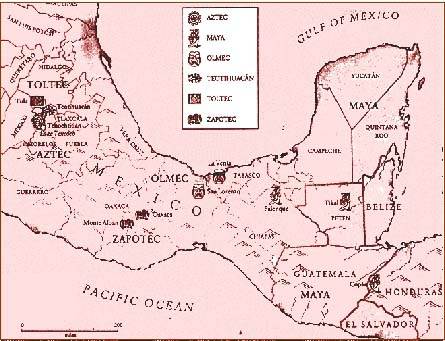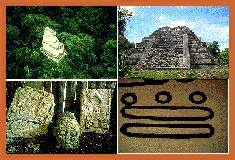|
 Click here to enlarge
Click here to enlarge
Exhibit 1.11
The Pre-Columbian Civilizations of Middle America
The Maya: The Mayas were contemporaries
of the Olmecs. While the latter civilization declined and disappeared,
the Mayas, by AD 300 had developed a remarkably advanced culture,
which flourished till AD 900. From the ruins, scholars have gathered
that the Mayans had built huge and aesthetically beautiful temples.
Besides their monumental architecture, the Mayans had also advanced
in astronomy, recording their observations in screen folds (books
made of lime covered bark paper). Mayan writers also wrote calendrical
religious inscriptions on ceramic vessels. These inscriptions and
records reveal that the Mayans had a well-developed script. Known
to be a peaceful people, who believed in the policy of ’live and
let live,’ this civilization buckled under the onslaught of the
weapon wielding Spaniards.

Exhibit 1.12
Mayan Ruins
In North America, the Indians did not settle
down to do agriculture due to the climatic conditions. Thus, they
did not make the advances their counterparts made in the South American
continent. There were various tribes like Beaver, Chippewe, Cree,
Chowo, Yellow Knife, Mohegans, etc. Since the growing season
was too short for agriculture, they gathered plants, nuts and berries.
Hunting and fishing were the chief activities. As far as shelter
was concerned, nomadic tribes used portable ’tepees’; while
the others built strong log homes to stay. Communal sharing
extended to land use, the hunt and the home. Although one particular
family ploughed a piece of land, they did not own it. It belonged
to the entire tribe. The women especially from the Iroquois
tribe played a major role in political matters. In this tribe (Iroquois)
which lived in villages, married men stayed or joined the family
of their wires. And while the women did the farming, the men went
out to hunt, fish and war. So influential was the authority of the
women in this tribe, that they sometimes prevented military expeditions
by refusing to supply food or footwear. Within the tribe, there
was a healthy spirit of competition in hunting, fishing and fighting,
children were brought up on egalitarian values. Without any written
laws or jails, order and discipline was maintained, by way of ostracism.
Though civilized, their lack of technological knowledge -
especially in the used of weapons, rifles, etc. and a lack of
unity between the various tribes were the 2 main reasons
for their inability to resist the European onslaught in the New
World.
Initially, these tribes accepted the white foreigners
in their midst, and helped them to adjust and learn about their
new environment. However, soon a bitter struggle ensued. For as
European settlements increased, land grabbing and the control of
fur trade at the expense of the native Indians caused a long, bloody
war in the north. Not content with cattle raising and sugar plantations,
the Spanish Monarchy wanted wealth to fill their coffers. Moreover,
rumors were afloat about the existence of civilizations in Mexico
and South America, known for their wealth.
|
Index
1.0
- Introduction
1.1 History: Meaning and Importance
1.2 Pre-historic Period
1.3 Early Civilizations
1.4 The Dark Age
1.5 The Medieval Period
1.6 Dates & Events
1.7 Points to Remember
Chapter 2
|